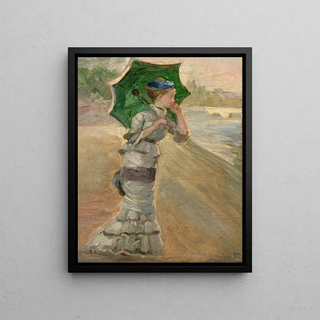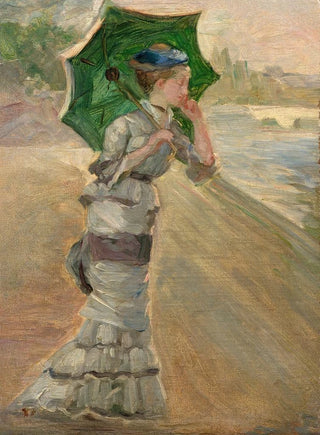Art print | Study of an elegant woman with parasol for En bateau Sisley and his wife - Marie Bracquemond


View from behind

Frame (optional)
In the fascinating world of impressionist art, the work "Étude de femme élégante au parasol pour En bateau Sisley et sa femme" by Marie Bracquemond stands out for its delicacy and timeless charm. This painting, which depicts a scene from everyday life, transports the viewer to a suspended moment where light plays with colors and nature reveals itself in all its splendor. Bracquemond, through this painting, invites us to contemplate not only the beauty of her subjects but also the harmony between man and his environment. The art print of this piece allows appreciation of the finesse of its execution and the depth of its message, while paying tribute to an artist often underrated in the impressionist landscape.
Style and uniqueness of the work
Bracquemond's work is characterized by a unique style that combines finesse and vibrancy. In "Étude de femme élégante au parasol pour En bateau Sisley et sa femme," the composition is marked by a masterful use of light and color. The woman, elegantly dressed, is highlighted by a play of shadows and reflections, while the parasol adds a touch of lightness to the scene. Brushstrokes, both swift and precise, create a vibrant, almost tangible atmosphere. The way Bracquemond captures movement and spontaneity reveals the impressionist spirit, but she also adds her own sensitivity that makes her work truly singular. Every detail, from the fabric of the dress to the leaves of the trees, is treated with care, demonstrating attentive observation of reality.
The artist and her influence
Marie Bracquemond, an emblematic figure of the impressionist movement, managed to establish herself in an artistic environment dominated by men. Her talent and vision were recognized by her contemporaries, but her work was long overshadowed by that of her male colleagues. Born in 1840, she was influenced by artists such as Claude Monet and Pierre-Auguste Renoir, but she also developed a personal style that is uniquely hers. Her commitment to the representation of women

Matte finish

View from behind

Frame (optional)
In the fascinating world of impressionist art, the work "Étude de femme élégante au parasol pour En bateau Sisley et sa femme" by Marie Bracquemond stands out for its delicacy and timeless charm. This painting, which depicts a scene from everyday life, transports the viewer to a suspended moment where light plays with colors and nature reveals itself in all its splendor. Bracquemond, through this painting, invites us to contemplate not only the beauty of her subjects but also the harmony between man and his environment. The art print of this piece allows appreciation of the finesse of its execution and the depth of its message, while paying tribute to an artist often underrated in the impressionist landscape.
Style and uniqueness of the work
Bracquemond's work is characterized by a unique style that combines finesse and vibrancy. In "Étude de femme élégante au parasol pour En bateau Sisley et sa femme," the composition is marked by a masterful use of light and color. The woman, elegantly dressed, is highlighted by a play of shadows and reflections, while the parasol adds a touch of lightness to the scene. Brushstrokes, both swift and precise, create a vibrant, almost tangible atmosphere. The way Bracquemond captures movement and spontaneity reveals the impressionist spirit, but she also adds her own sensitivity that makes her work truly singular. Every detail, from the fabric of the dress to the leaves of the trees, is treated with care, demonstrating attentive observation of reality.
The artist and her influence
Marie Bracquemond, an emblematic figure of the impressionist movement, managed to establish herself in an artistic environment dominated by men. Her talent and vision were recognized by her contemporaries, but her work was long overshadowed by that of her male colleagues. Born in 1840, she was influenced by artists such as Claude Monet and Pierre-Auguste Renoir, but she also developed a personal style that is uniquely hers. Her commitment to the representation of women






